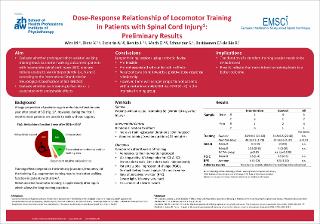Please use this identifier to cite or link to this item:
https://doi.org/10.21256/zhaw-2735| Publication type: | Conference poster |
| Type of review: | Peer review (abstract) |
| Title: | Dose-response relationship of locomotor training in patients with spinal cord injury : preliminary results |
| Authors: | Wirz, Markus Dietz, Volker Esclarin, Ana Benito, Jesus Mach, Orpheus Schneider, Sandra Bastiaenen, Carolien de Bie, Rob |
| DOI: | 10.21256/zhaw-2735 |
| Conference details: | World Confederation for Physical Therapy Congress 2015, Singapore, 1-4 May 2015 |
| Issue Date: | May-2015 |
| Publisher / Ed. Institution: | World Confederation for Physical Therapy (WCPT) |
| Language: | English |
| Subject (DDC): | 615.82: Physical therapy 617: Surgery |
| Abstract: | Background: A large proportion of patients with spinal cord injury (SCI) regain ambulatory function. However, during the first 3 months most patients are unable to walk without support. To enable ambulatory training at such an early stage the body weight is partially relieved and leg movement assisted by two therapists. A more recent approach is the application of robotic-based assistance, which allows for longer training duration. From the science of motor learning and studies including patients with stroke, it is known that training effects depend on the duration of the training. Longer training results in a better walking function. Purpose: The aim of the present study is to evaluate whether prolonged robot-assisted walking training leads to a better walking outcome in patients with incomplete SCI, who are initially unable to walk independently (i.e. B and C according to the International Standards for Neurological Classification of SCI-ISNCSCI), and whether such training is feasible or is associated with undesirable effects. Methods: Patients from three sites with an acute incomplete SCI (within 60 days after injury) were randomized to either standard training (session duration 25 minutes) or intensive training (session duration 50 minutes). After 8 weeks of training walking ability (Walking Index for SCI-WISCI, scale 0-20: 0=not able to walk, 20= able to walk independently), the occurrence of adverse events and the rate of perceived exertion (RPE, scale 1-10: 1=very light, 10= very, very hard), as well as patients’ global impression of change (PGIC, scale 0 -10: 0= much better, 5= no change, 10= much worse) were compared between groups. Results: Seventeen patients with incomplete SCI were randomly assigned either to standard training (ISNCSCI B: n=6; C: n=2) or to intensive training (B: n=3; C: n=6). The average duration of training of the standard group was half the length of the intensive group (24.9±0.6 minutes vs. 48.3±3.2 minutes; p=0.01). Both groups performed an equal number of training sessions within 8 weeks (33.8±6.8 and 34.9±6.0; n.s.). The median WISCI changed from 0 to 4 in the standard group (n.s.) and from 0 to 10.5 (p<0.05) in the intensive group. However, the group difference after training did not reach statistical significance. The median RPE (standard: 6.5, range 1-10 and intensive: 6, range 1-10; n.s.) and the PGIC (standard: 3.5, range 0-5; intensive: 2.5, range 1-4; n.s.) did not differ between the standard and intensive training groups. Conclusions: Longer training using a robotic device is feasible and is not associated with undesirable effects in patients with incomplete SCI. Results show a trend towards a positive dose-response relationship. However, there was a larger proportion of patients with a motor incomplete SCI (i.e. ISNCSCI: C) in the intensive training group. Implications: The duration of a standard training session needs to be re-addressed. Results indicate that more intensive training leads to a better outcome. |
| URI: | https://digitalcollection.zhaw.ch/handle/11475/12031 |
| Fulltext version: | Published version |
| License (according to publishing contract): | Licence according to publishing contract |
| Departement: | School of Health Sciences |
| Organisational Unit: | Institute of Physiotherapy (IPT) |
| Appears in collections: | Publikationen Gesundheit |
Files in This Item:
| File | Description | Size | Format | |
|---|---|---|---|---|
| wcpt_poster_wirm_150417.pdf | Poster | 1.58 MB | Adobe PDF |  View/Open |
Show full item record
Wirz, M., Dietz, V., Esclarin, A., Benito, J., Mach, O., Schneider, S., Bastiaenen, C., & de Bie, R. (2015, May). Dose-response relationship of locomotor training in patients with spinal cord injury : preliminary results. World Confederation for Physical Therapy Congress 2015, Singapore, 1-4 May 2015. https://doi.org/10.21256/zhaw-2735
Wirz, M. et al. (2015) ‘Dose-response relationship of locomotor training in patients with spinal cord injury : preliminary results’, in World Confederation for Physical Therapy Congress 2015, Singapore, 1-4 May 2015. World Confederation for Physical Therapy (WCPT). Available at: https://doi.org/10.21256/zhaw-2735.
M. Wirz et al., “Dose-response relationship of locomotor training in patients with spinal cord injury : preliminary results,” in World Confederation for Physical Therapy Congress 2015, Singapore, 1-4 May 2015, May 2015. doi: 10.21256/zhaw-2735.
WIRZ, Markus, Volker DIETZ, Ana ESCLARIN, Jesus BENITO, Orpheus MACH, Sandra SCHNEIDER, Carolien BASTIAENEN und Rob DE BIE, 2015. Dose-response relationship of locomotor training in patients with spinal cord injury : preliminary results. In: World Confederation for Physical Therapy Congress 2015, Singapore, 1-4 May 2015. Conference poster. World Confederation for Physical Therapy (WCPT). Mai 2015
Wirz, Markus, Volker Dietz, Ana Esclarin, Jesus Benito, Orpheus Mach, Sandra Schneider, Carolien Bastiaenen, and Rob de Bie. 2015. “Dose-Response Relationship of Locomotor Training in Patients with Spinal Cord Injury : Preliminary Results.” Conference poster. In World Confederation for Physical Therapy Congress 2015, Singapore, 1-4 May 2015. World Confederation for Physical Therapy (WCPT). https://doi.org/10.21256/zhaw-2735.
Wirz, Markus, et al. “Dose-Response Relationship of Locomotor Training in Patients with Spinal Cord Injury : Preliminary Results.” World Confederation for Physical Therapy Congress 2015, Singapore, 1-4 May 2015, World Confederation for Physical Therapy (WCPT), 2015, https://doi.org/10.21256/zhaw-2735.
Items in DSpace are protected by copyright, with all rights reserved, unless otherwise indicated.